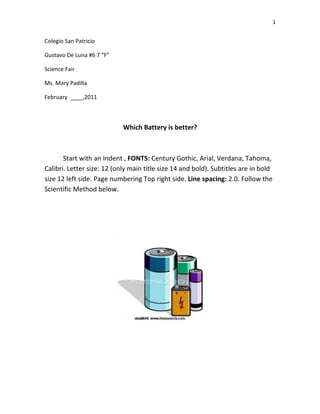
Booklet
- 1. 1 Colegio San Patricio Gustavo De Luna #6 7 “F” Science Fair Ms. Mary Padilla February ____,2011 Which Battery is better? Start with an Indent , FONTS: Century Gothic, Arial, Verdana, Tahoma, Calibri. Letter size: 12 (only main title size 14 and bold). Subtitles are in bold size 12 left side. Page numbering Top right side. Line spacing: 2.0. Follow the Scientific Method below.
- 2. 2 The Scientific Method Research Question: The research question is the single most important part of the scientific method. Every part of your project is done to answer this question. The research question is sometimes formed as a statement and is called the "Problem" or "Problem Statement." Hypothesis: The hypothesis is an "educated guess," formed as a statement, that you propose to be the answer to the research question. An educated guess is based on some prior knowledge. Experimental Design: Plan an experiment in which you can test your hypothesis. •Variables: The experiment will contain an element or elements that do not change (called controlled variables or dependent variables) and elements that will change (called manipulated variables or independent variables). •Control: The control is a particular sample that is treated the same as all the rest of the samples except that it is not exposed to manipulated variables. •Observation: When you interact with your experiment, you are using your senses to observe. Does it have a smell, make a noise have color, etc.? •Collect Data: As you observe your experiment, you will need to record the progress of your experiment. Data can be whatever you observe about your experiment that may or may not change during the time of the experimentation. Examples of data are values in pH, temperature, a measurement of growth, color, distance, etc.
- 3. 3 •Journal: All scientists keep a record of their observations in some form of a journal. The journal will begin with the date and time the experimentor collects the data. Sometimes data will include environmental values such as humidity, temperature, etc. Entries must be written clearly and with detail of description so that another scientist can read the journal, simulate the conditions of the experiment, and repeat the experiment exactly. •Data: The data are the values written down as the experiment progresses. Examples of data entry on measuring plant growth: 11/15/04 Control Plant 7.4 mm Test Plant 16.2 mm Test Plant 24.9 mm Test Plant 37.2 mm 11/22/04 Control Plant 7.8 mm Test Plant 15.9 mm Test Plant 23.2 mm Test Plant 37.2 mm •Charts & Graphs: When at all possible, illustrations of data are advisable. They create a professional appearance and convey a great deal of information. Examples include: Bar Graph, Pie Chart, X & Y axis Graph, Histogram, etc.
- 4. 4 Materials: List all supplies and equipment. Example: 250 ml. glass beaker 1 straw 150 ml. Lime Water 10 g. Baking Soda Procedure: The procedure is a somewhat detailed, step - by - step description of how you conducted your experiment. Example: "After 1 minute, I stirred in the baking soda and timed the reaction to be 45 seconds." Results: The results is usually in the form of a statement that explains or interprets the data. You do not go into any detail or explanations here. You simply say in words what your data is telling you. Example: "Test Plant 3 showed little difference in growth rate as compared to the Control Plant." Conclusion: The conclusion is a summary of the research and the results of the experiment. This is where you answer your research question. You make a statement of whether your data supported your hypothesis or not. You may have data that supported part of your hypothesis and not another part. You may also have data that did not support your hypothesis at all. In this case, you may explain why the results were different. Resources: One of the most important things for a student to do is recognize the people and resources used in developing and conducting the project. Name the people who offered knowledge or helped, and list the web sites, retail stores, magazines, books, computer programs, etc. that were used as sources of information or supplies.